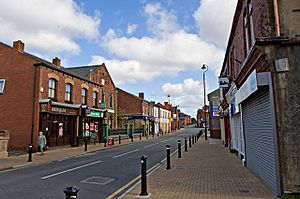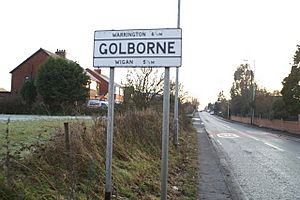Golborne facts for kids
Quick facts for kids Golborne |
|
|---|---|
 High Street, Golborne |
|
| Population | 24,169 (2011 census) |
| OS grid reference | SJ606978 |
| Metropolitan borough |
|
| Metropolitan county | |
| Region | |
| Country | England |
| Sovereign state | United Kingdom |
| Post town | WARRINGTON |
| Postcode district | WA3 |
| Dialling code | 01925 01942 |
| Police | Greater Manchester |
| Fire | Greater Manchester |
| Ambulance | North West |
| EU Parliament | North West England |
| UK Parliament |
|
Golborne is a town in Greater Manchester, England. It's located about 5 miles (8 km) south-southeast of Wigan. It's also about 6 miles (10 km) northeast of Warrington and 14 miles (23 km) west of the big city of Manchester. When you include the nearby village of Lowton, Golborne has a population of around 24,041 people.
Golborne is in the historic county of Lancashire. It's also right on the A580 East Lancashire Road. In the past, Golborne grew a lot because of its mining and textile factories. Even though these industries aren't as big now, there was also a lot of farming. Many farms still belong to the same families who owned them a long time ago.
Contents
History of Golborne
What's in a Name?
The name Golborne comes from old English words. Golde means "marsh marigolds" (a type of flower) and burna means "stream." So, Golborne means "stream where marsh marigolds grow."
The first settlements in Golborne were near the Millingford Brook. This is why its name comes from a water source. Over time, the spelling of Golborne has changed. In 1187, it was called Goldeburn. Later, it was Goldburc, Goseburn, Goldburn, and Golburne. In the 1500s, people sometimes spelled it Golborne or Gowborne.
Early Times
People have lived in Golborne since at least the time of the Domesday book. This was a very old survey of England ordered by William the Conqueror. The land in Golborne was owned by two main groups. One half was owned by the Lords of Lowton. The other half was owned by the Golborne family. Later, other families like the Fleetwoods and Leghs owned parts of the land.
The old Manor of Golborne was a large house and estate. It was located north of the village. It even gave its name to a pub on Church Street, which is now gone. The manor's land stretched all the way to St Luke's Church in Lowton. You can still see its influence in names like Manor Avenue and Manor Court.
Some people thought that a well near Golborne was where a famous battle happened in 642 AD. In this battle, a pagan king named Penda killed the Christian King Oswald. However, most historians now agree that the battle happened much further away, near a place called Oswestry.
Holcroft Hall is now a farm, but it used to be the home of Colonel Blood. He was a very daring person who tried to steal the Crown Jewels from King Charles II. The King was so impressed by Blood's bravery that he actually pardoned him! Colonel Blood married Maria Holcroft from Holcroft Hall.
In 1648, a battle called the Battle of Red Gap took place near Golborne. This was during the English Civil War. The Scottish army, who supported King Charles I, had marched into England. Oliver Cromwell, who led the Roundhead Army, fought them. Even though Cromwell's army was much smaller, he defeated the Scots in a series of battles, including the one at Red Gap.
Modern History
Golborne grew very quickly during the Industrial Revolution. This was a time when many new factories and mines were built. The mining industry, especially, became very important in Golborne.
Sadly, on March 18, 1979, there was a methane gas explosion at the town's coal mine. This terrible accident caused the deaths of ten miners. Only one person survived out of the eleven who were there. The coal mine finally closed in 1989. The area where the mine used to be is now a large park called the Bonk.
When the mine closed, many people in Golborne lost their jobs. This also affected people from nearby towns like Abram and Lowton. However, in recent years, new industries have come to Golborne. This has created new jobs and helped solve the unemployment problems. Places like Stone Cross Industrial Park and Golborne Enterprise Park have brought in many new businesses.
There is also a campaign to reopen Golborne's main railway station, called Golborne South. The Mayor of Greater Manchester, Andy Burnham, believes that Golborne has a strong reason to have a station again. He says it would greatly improve transport for the area.
How Golborne is Governed
"Governance" means how a town or area is managed and run. Before 1974, Golborne was its own "urban district." This meant it had its own local government.
However, in 1974, a new law changed how local areas were organized. Golborne was split up. Some parts became part of the Warrington district in Cheshire. The rest of Golborne became part of the Metropolitan Borough of Wigan in Greater Manchester. This is how Golborne is governed today.
Population Changes
The table below shows how Golborne's population has grown over many years.
| Population growth in Golborne since 1901 | ||||||||
|---|---|---|---|---|---|---|---|---|
| Year | 1901 | 1911 | 1921 | 1931 | 1939 | 1951 | 1961 | 2001 |
| Population | 6,789 | 6,931 | 7,183 | 7,321 | 13,845 | 16,878 | 21,310 | 20,007 |
| Source: A Vision of Britain through Time | ||||||||
Important Places in Golborne
Golborne has several important landmarks.
- St Thomas' Church: This is the main church in Golborne. It was built in 1829. The church building has a clock tower that still works and chimes every hour. There is also a graveyard around the church.
- Peter Kane Square: This square in the town centre is named after a local boxer, Peter Kane. There is also a memorial clock there.
- Colliery Memorial: On March 19, 2006, a special service was held to remember the miners of Golborne. A stone memorial was placed at the entrance to the old Golborne Colliery. This memorial honors the men and women who worked and died at the mine from 1880 until it closed in 1989. Former miners and their families helped raise money for the memorial.
- Cenotaph Memorial: There is also a war memorial, called a cenotaph, at the corner of Legh Street and Barn Lane.
Famous People from Golborne
Many interesting people have come from Golborne, including:
- Johnny Hart (1928-2018), a professional football player and manager.
- Paul Hart (born 1953), a professional footballer and Johnny Hart's son.
- William 'Billy' Hibbert (1884–1949), a professional footballer.
- Peter Kane (1918–91), a blacksmith and professional boxer.
- Bert Llewellyn (1939–2016), a professional footballer.
- Philip McGinley (born 1981), an actor.
- Jimmy Pennington (born 1939), a professional footballer.
- Jack Rigby (1924–97), a professional footballer.
- Danny Tickle, (born 1983), a professional rugby league player.
- Brian Simpson (born 1953), who was a Member of the European Parliament.
- Davey Boy Smith (1962–2002), a professional wrestler.
- Thomas Billington (aka: Dynamite Kid, 1958–2018), a professional wrestler.
- Chris Washington (born 1989), a comedian.
- Matty Hughes (born 1992), a professional footballer.
- Charlie Hughes (born 2003), a professional footballer.
See also
 In Spanish: Golborne para niños
In Spanish: Golborne para niños



